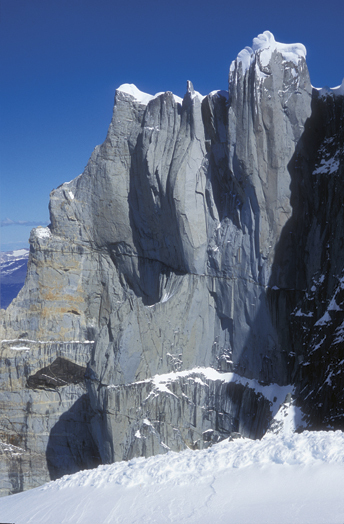In 2003 and 2004, always in November
and December, Robert Jasper and I dragged ourselves to the base of the
1000-meter-high north wall of Cerro Murallon (2656m), failing
both times. In 2005 we returned; the mountain had possessed us. Hans
Martin Gotz and the photographer Klaus Fengler would join us three
weeks later.

The north face of Cerro Murallon (2656m), Argentine Patagonia, showing Vom Winde Verweht (“Gone With the Wind”: VI 5.13- A2, 27 pitches). Glowacz and Robert Jasper completed their route on their third attempt in three years, summiting at 9 p.m. on November 13 after a two-day push and rappelling through the night to reach camp. [Photo] Klaus Fengler
After a week of snowstorms, the barometric pressure stabilized itself at
its lowest level. Last year we’d had the same conditions. But then,
although the pressure rose no more than five millibars, the storm went
away and the sky cleared overnight. At 3 a.m. we left the cave, and for
the first time in a week, we walked upright for more than ten steps.
In 2004 we’d climbed to 300 meters below the summit, above the main
difficulties, when gale-force storms stopped us. Now we had to climb
each meter again with fixed ropes. Since there were only two of us to do
all the work, we had to carry more weight, rest less frequently and
experience a higher level of risk than if we’d been with a larger team.
Furthermore, we wanted to climb this big wall without using any bolts
and thus to demonstrate our concept of modern expeditions.
The difficulties increased from pitch to pitch, but we knew the crux
sequences from last time, and by the second day we’d climbed half of the
lower pillar. We devised a bold plan: in the next good-weather window
we’d take enough fixed rope and food to reach the headwall, bivouac
there and then keep climbing the next day until we reached the summit.
For now, we returned to the cave and awaited our moment.
After another three-day snowstorm, we began our final ascent. It was
like riding a cannonball. In order to save time, we jumared the shreds
of our fixed rope from the previous year’s attempt, which sometimes
consisted of no more than five strands.
We’d been climbing for fifteen hours when we finally arrived at the bivy
site under the headwall. Since we’d sacrificed some of our bivy gear in
order to carry more fixed rope, we sat shivering in our Gore-Tex shells
and bivy sacks and waited longingly for morning.
Soon after 5 a.m. Robert started up the last section. It was bitterly
cold, but we couldn’t wait any longer. Cirrus clouds had come during the
night: a sign of bad weather. We wondered whether it would hold off long
enough for us to reach the summit. There were just three pitches left
before our earlier high point. This section is so overhanging that we
had to fix ropes; otherwise we would’ve had no chance of rappelling the
route on the descent. Robert toiled through meter after meter of aid; it
was far too cold for free climbing. Not until 11 p.m. did we reach new
ground, the unknown final 300 meters.
Ropelength after ropelength the wall became a little less steep. We came
to a giant system of frozen cracks and chimneys. Almost each nut and
Friend placement had to be painstakingly chopped out of the ice, while a
jet-black cloudbank approached us, fast and menacing. Again we switched
leads; my free-climbing skills were useless in the iced-up cracks of the
last two pitches. We were so tense that we lost all sense of time. It
kept getting darker and colder, and the first flakes floated down. We
were racing against the power of nature.
At 9 p.m. Robert reached the summit plateau; I followed him, jumaring
the fixed rope. Shreds of clouds whirled about the edge. We embraced
without speaking. This magic line had possessed us for three years. We
had focused our lives on it. Perhaps in that moment we felt nothing but
an unbelievable relief. And also we were concentrating on the more than
1000 meters of rappelling in the snowstorm that still lay before us–an
adventure in itself. But our success had lent us no wings, only a due
portion of euphoria and imperturbability for this final part. At 3 a.m.
we arrived, completely worn-out, back at our ice cave, having
established Gone with the Wind (VI 5.13- A2, 1000m).
Stefan Glowacz, Garmisch-Partenkirchen, Germany